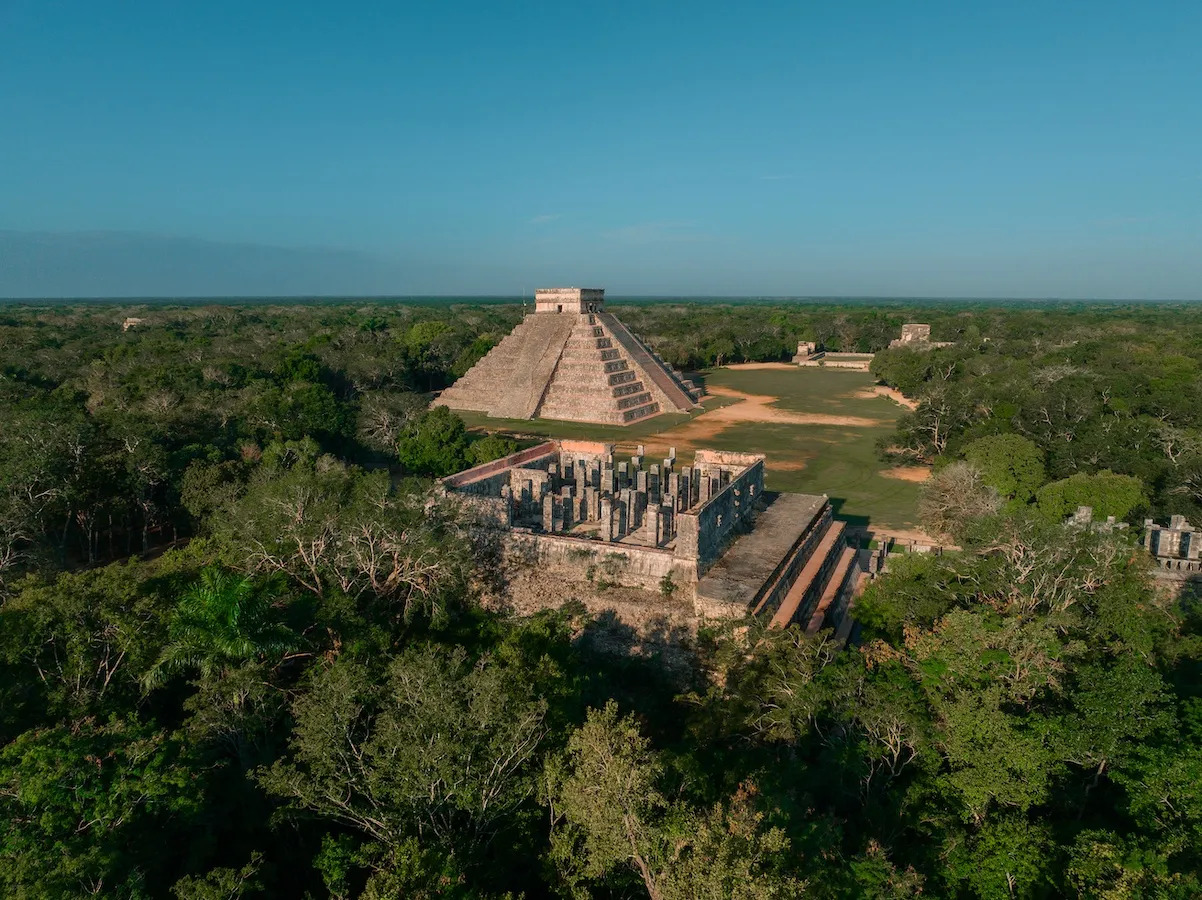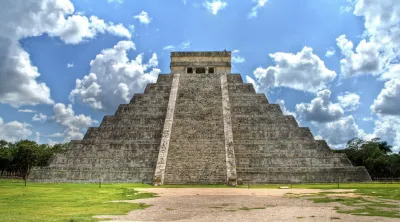
One of the largest Maya cities, with an estimated population of 35,000 at its peak, Chichén Itzá was founded around the sixth century on the Yucatán peninsula. Its name roughly translates to “at the mouth of the Itzás’ well,” the Itzá being a subgroup of the Maya people who eventually inhabited the settlement. The wells in question were cenotes, sinkholes in the limestone bedrock that provided the metropolis’s water. They were also sites of human sacrifice: Victims were thrown into the sinkholes to appease the rain god Chaac.
Unprecedented among major Mesoamerican ruins, the surviving architectural projects at Chichén Itzá fuse Maya and Toltec styles. The most prominent of these is the towering (78-foot-tall) central pyramid known as El Castillo, a temple dedicated to the feathered serpent god Kukulcán (the Maya equivalent of the Aztecs’ Quetzalcoatl). Other structures of note include the Great Ball Court, Colonnade, Tzompantli (skull rack), Temple of the Jaguar, and Temple of the Warriors with its distinctive reclining Chacmoolsculptures. The site was named a UNESCO World Heritage site in 1988 and a New Wonder of the World in 2007.
What makes the Temple of Kukulcán so special?
Every detail of the pyramid’s architecture reflects the Maya’s extraordinary astronomical knowledge—fitting, since the temple was likely used at least in part as an observatory. Counting all four sides, the Temple of Kukulcán has 365 steps, corresponding to the number of days in the year. At the spring and autumn equinoxes, the pyramid’s terraces cast an undulating shadow on a banister of its front-facing stairs, making the stone serpent head at the base appear as though it is slithering down the building’s side.
Another tribute to Kukulcán may be hidden in the temple’s acoustics. If visitors clap at the base of the stairs, the sound bounces back from the cavity at the top of the pyramid. From the ground, some swear the distorted echo sounds like the cry of a quetzal.
Recent radar and imaging technology has revealed a smaller, 50-foot pyramid underneath the El Castillo, as well as a cenote, which at some point was blocked off by its builders.

What kind of game was played in the Great Ball Court?
The movie The Road to El Dorado (2000) has a ball game scene that gets pretty close to the original. The game is mentioned in records across Mesoamerican cultures and was known as pok-ta-pok to speakers of the Mayan language. In it, players bumped a heavy ball (weighing 8 to 12 pounds) off their bodies until it sailed through a stone hoop. Participants weren’t playing for funsies, either: Historians believe that in some cases the losers were sacrificed. (It may not be a coincidence that reliefs carved into Chichén Itzá’s Great Ball Court depict a member of the losing team being decapitated.) At more than 550 feet long and 230 feet wide, the ball court is the largest yet discovered in the Americas. Twelve other, smaller ball courts have been discovered in Chichén Itzá to date.
Why did people abandon Chichén Itzá?
We don’t know, as the ruins themselves bear no signs of disease or hostile takeover. As in other Mesoamerican cities of the period, most residents of Chichén Itzá appear to have left voluntarily for more rural areas sometime in the 15th century.
Inevitably, conquistadors did sweep through Chichén Itzá a century later. Francisco de Montejo, who conquered the Yucatán, was so struck by Chichén Itzá’s features that he considered establishing a new capital there. The plan didn’t pan out, and the site instead became a cattle ranch. It remained largely intact, if dilapidated and overgrown, until researchers surveyed and excavated the site in the 19th and early 20th centuries.
Medieval Shipwreck Unearthed Beneath Barcelona’s Mercat del Peix
Historic Shipwrecks Discovered Near Greek Island Reveal Ancient Cargo

Why A-Listers Are Flocking to Spain’s San Sebastian

Delta is using AI to charge some people more for tickets than others

NFLPA Fires Arbitrator Who Ruled on JC Tretter ‘Fake Injuries’ Case



